
Aristotelia serrata, commonly known as wineberry or in the Māori language makomako or just mako, is a small tree in the family Elaeocarpaceae, in the genus Aristotelia, found in the North Island, South Island and Stewart Island of New Zealand. It is a small deciduous fast-growing tree or shrub. The tree can reach up to 10m tall, with a trunk diameter up to 30 cm. The bark is pale brown, smooth and patterned with flat lenticels. Branches are long, slender and spreading, branchlets have a reddish-brown color when pubescent.

Acalypha is a genus of flowering plants in the family Euphorbiaceae. It is the sole genus of the subtribe Acalyphinae. It is one of the largest euphorb genera, with approximately 450 to 462 species. The genus name Acalypha is from the Ancient Greek ἀκαλύφη (akalúphē) ("nettle"), an alternative form of ἀκαλήφη (akalḗphē), and was inspired by the nettle-like leaves. General common names include copperleaf and three-seeded mercury. Native North American species are generally inconspicuous most of the year until the fall when their stems and foliage turn a distinctive coppery-red.

Carpinus caroliniana, the American hornbeam, is a small hardwood tree in the genus Carpinus. American hornbeam is also known as blue-beech, ironwood, musclewood and muscle beech. It is native to eastern North America, from Minnesota and southern Ontario east to Maine, and south to eastern Texas and northern Florida. It also grows in Canada. It occurs naturally in shaded areas with moist soil, particularly near the banks of streams or rivers, and is often a natural constituent understory species of the riverine and maritime forests of eastern temperate North America.

Codiaeum variegatum is a species of plant in the genus Codiaeum, which is a member of the family Euphorbiaceae. It was described by Carl Linnaeus in 1753. It is native to Indonesia, Malaysia, Australia, and the western Pacific Ocean islands, growing in open forests and scrub.

The Saint Helena olive is an extinct species of flowering plant. It is the only member of the genus Nesiota. It was endemic to the island of Saint Helena in the South Atlantic Ocean. Despite its name, it is unrelated to the true olive, but is instead a member of the family Rhamnaceae, the family which contains buckthorns and jujube. The last remaining tree in the wild died in 1994, and the last remaining individual in cultivation died in December 2003, despite conservation efforts. It is thus a prime example of recent plant extinction. The Saint Helena olive belongs to the tribe Phyliceae, which are mostly endemic to Southern Africa.
Lachanodes arborea, the she cabbage tree, is a small tree in the family Asteraceae. It is an endangered endemic of the island of Saint Helena in the South Atlantic Ocean. It is now extinct in the wild.
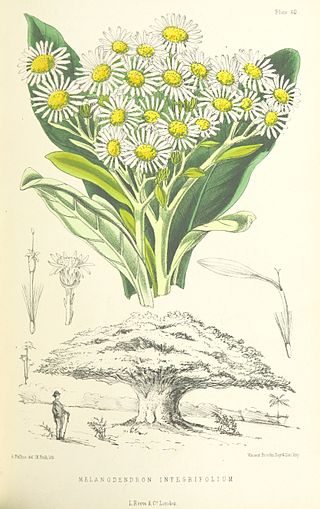
Melanodendron is a genus of trees in the family Asteraceae, with only one species, Melanodendron integrifolium, native to the island of Saint Helena. It is related to the Saint Helenan gumwoods and is the most common of the remaining cabbage tree species of Saint Helena, although it is considered endangered due to the restricted population size.
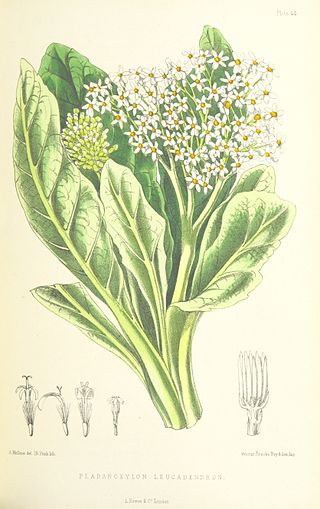
Pladaroxylon is a genus of trees in the tribe Senecioneae within the family Asteraceae.
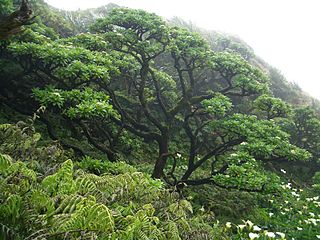
The flora of Saint Helena, an isolated island in the South Atlantic Ocean, is exceptional in its high level of endemism and the severe threats facing the survival of the flora. In phytogeography, it is in the phytochorion St. Helena and Ascension Region of the African Subkingdom, in the Paleotropical Kingdom.

Trochetiopsis ebenus, the dwarf ebony or Saint Helena ebony, is a species of flowering plant that is endemic to the island of Saint Helena in the southern Atlantic Ocean. It is not related to the ebony of commerce, but is instead a member of the mallow family, Malvaceae. Saint Helena ebony is now critically endangered in the wild, being reduced to two wild individuals on a cliff, but old roots are sometimes found washed out of eroding slopes. These are collected on the island a used for inlay work, an important craft on Saint Helena. A related species, Trochetiopsis melanoxylon is now completely extinct.
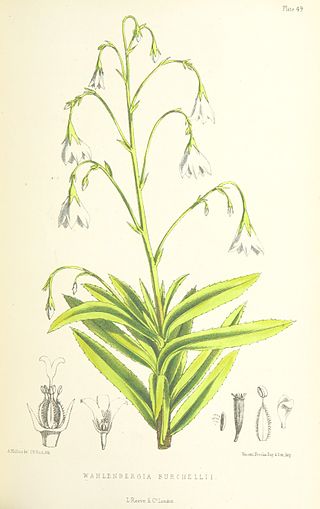
Wahlenbergia roxburghii, the Roxburgh bellflower or dwarf cabbage tree, is an extinct member of a group of four species of Wahlenbergia once known from the island of Saint Helena, in the South Atlantic Ocean. It was last seen by naturalist John Charles Melliss in 1872. William Roxburgh recorded it in the thick forests on the south face of Diana's Peak. De Candolle notes it in dense woods around Diana's Peak and Halley's Mount. Burchell notes it 'On Sandy Bay ridge near Taylor's. Flowering: probably August to March. It was exceedingly rare in Meliss's time, it is not in his book as he had not found it. It was probably the increase of Phormium tenax planting on the ridge that pushed Wahlenbergia roxburghii into final extinction. It is an example of one of the early extinctions of Saint Helena plants as a result of human activity, with a history similar to that of the stringwood, .
Heliotropium pannifolium, the Saint Helena heliotrope, is now extinct but was formerly a hairy-leaved small shrub up to 1 m in height. it was only seen once, by the explorer W. Burchell in Broad Gut, Saint Helena and has never been seen again. Human impact on the island of Saint Helena was severe and the Saint Helena heliotrope is one of several extinct plants from that island.

Commidendrum robustum, the Saint Helena gumwood, is a species of tree endemic to Saint Helena, Ascension and Tristan da Cunha. Though it is now comparatively rare, it was once one of the most abundant trees of mid-elevations of the island of Saint Helena in the South Atlantic Ocean. A small tree to 7–8 m, it was cut extensively for fuel in the early years of settlement of the island by the English East India Company. It has given its name to certain placenames on the island such as "Gumwoods". It is one of several species in the endemic genus Commidendrum.

Lobelia scaevolifolia is a species of the plant family Campanulaceae. It is endemic to the island of Saint Helena in the South Atlantic Ocean. It was at one time placed as the only species, Trimeris scaevolifolia, in the genus Trimeris. Its common name is St. Helena lobelia.

Mellissia was formerly a monotypic genus in the family Solanaceae with the single species, Mellissia begoniifolia, endemic to the island of Saint Helena. It was named by Joseph Dalton Hooker in honour of John Charles Melliss, a 19th-century engineer and amateur naturalist who worked on Saint Helena. The plant is now known correctly as Withania begoniifolia (Roxb.) Hunz. & Barboza, the genus Mellissia having been subsumed in the genus Withania.

Nesohedyotis is a genus of flowering plants endemic to the island of Saint Helena in the South Atlantic Ocean. It in the family Rubiaceae.
Anisoptera reticulata is a tree in the family Dipterocarpaceae. The specific epithet reticulata means "netted", referring to the leaf veins.
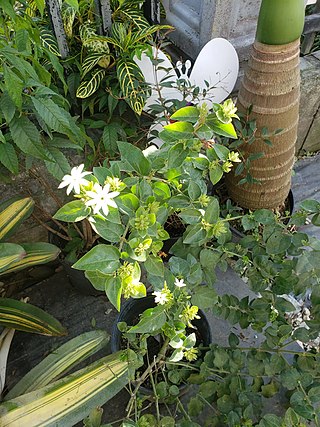
Buxus citrifolia is a species of plant in the family Buxaceae. It is found in Colombia, Panama, and Venezuela. This interesting shrub has not been known to occur in Central America, having only been collected and/or reported in Cuba, Puerto Rico, and Venezuela. Buxus citrifolia is nearly extinct and has been on the endangered list.

Campylospermum serratum is a plant in the family Ochnaceae. The specific epithet serratum is from the Latin meaning "with teeth", referring to the leaf margin. It is found in Tropical Asia, from Sulawesi, Indonesia to Hainan, Zhōngguó/China and over to southwester India. Gomphia serrata was a previous common name for the species. The plant is used for it wood and its sap is used in folk medicine and in the past for teeth-blackening.
Schoepfia harrisii is a species of flowering plant in the Schoepfiaceae family. It is a small tree or shrub, growing two to five metres tall. It is endemic to Jamaica, where it is only known to occur in the parishes of Trelawny and Clarendon, in what is known as Cockpit Country, a region of many steep, rounded, limestone hills, shaped like an egg-carton. Here it grows on crags in moist woodland, between 600 and 900m in elevation.

















